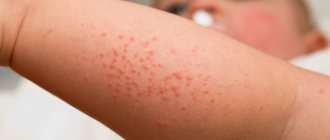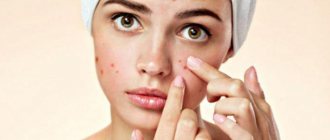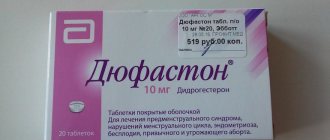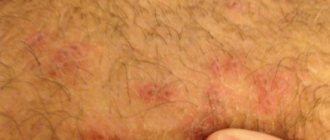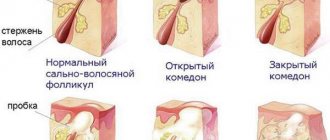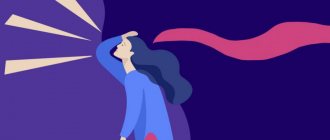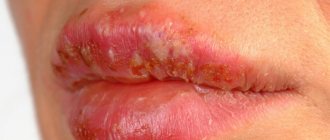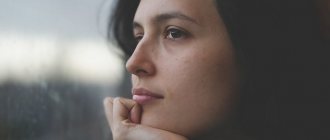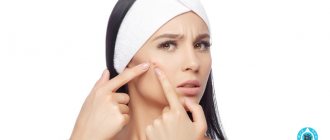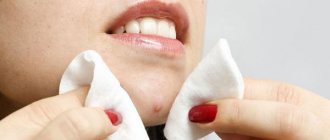Acne (otherwise acne, acne) is an inflammation of the sebaceous glands and hair follicles, manifested by the appearance of many rashes on the skin (mainly on the face and back). One of the main predisposing factors in the development of pathology is the active development of bacteria in the ducts of the sebaceous glands. That is why antibiotic therapy is an integral part of acne treatment. Antibiotics for acne act on one of the main causes of inflammation, allowing you to get rid of unpleasant skin pathology that brings aesthetic discomfort.
Acne after using antibiotics
(15.00 out of 5) Loading...
The area where acne appears is responsible for the functioning of a certain internal human organ.
And acne on the face after antibiotics signals a decrease in the performance of the organ. Usually, taking antibiotics contributes to the occurrence of intestinal dysbiosis - this is a fairly well-known disease after antibiotics.
After all, antibiotics reduce the performance of the body, as well as the intestines, mucous membranes and human skin.
When pimples appear after taking antibiotics, it means that the internal organs are not functioning at full capacity and changes have occurred in them.
In the end, the modified microflora of the body begins to be affected by pus-like viruses.
When the microflora is in order and functioning normally, staphylococci protect it from foreign organisms, but the slightest attack, for example, by antibiotics, causes the entire body to malfunction. As a result, acne appears on the face.
Masking pimples, squeezing them and using medications will expose the body to worsening the situation and the occurrence of skin diseases. When the course of antibiotics is not taken for a long time, then the acne on the face is short-lived.
They often disappear on their own without treatment. And when treatment with antibiotics for a long time and this affects the functioning of the sebaceous glands, you should go to the doctors to remove them and improve the skin.
The effect of antibiotics on the human body is unpredictable. An example of this is multiple acne breakouts.
The appearance of a rash on the skin spoils the appearance, brings discomfort to life and is a reason to abandon the previous life. There are many factors that contribute to the appearance of acne on the skin. The main ones are imbalances and problems with intestinal microflora.
In most cases, acne after antibiotics is considered an indicator of non-compliance with the treatment regimen prescribed by the doctor. A weakened immune system is unable to independently protect the body from the resulting imbalance. The appearance of acne is the first confirmation of this fact.
In addition to these underlying causes, acne after taking antibiotics can be associated with factors such as:
- Hypersensitivity of the body to the main active component of the drug. The first reaction to taking medications makes itself felt thanks to the sebaceous glands. This is noticeable in the form of redness of the surface layer of the skin, the appearance of acne and pimples. Medical observations show that most often inflammatory processes occur after consuming the penicillin group of antibiotics.
- Allergic reaction. Practice shows that many patients do not know which component of the drug is dangerous to the body. The patient first learns about it after an allergic reaction, which manifests itself in the form of a change in skin color and the appearance of a rash. The danger of the reaction is that it can be unpredictable. In serious cases, after taking antibiotics, anaphylactic shock may occur, requiring emergency medical intervention. Carrying out intradermal testing allows you to quickly identify the allergen and help the patient.
- Genetic predisposition. Acne after taking antibiotics may be due to a hereditary factor. To confirm your own assumptions, it is enough to discuss the problem with people close to you by blood.
- The body's response to long-term therapy. In some patients, a connection between acne and antibiotics is noted some time after the main course of treatment. This reaction is a delayed response of the body to the maximum accumulation of the antibiotic in the body after therapeutic treatment.
Whatever the reason, the appearance of a rash, pimples, acne or inflammatory processes is the first signal of a malfunction in the body. Contacting a specialist for advice allows you to answer the question of why acne appeared after antibiotics and what to do about it.
If acne appears after taking antibiotics, the patient is strictly prohibited from self-treatment with medical and cosmetic preparations. It is not allowed to squeeze or burn formations on the face.
Damage to the superficial tubercle can cause infection, which quickly spreads throughout the body.
Self-administration of antibiotics for acne can cause disruption of the intestinal microflora and other complications.
Treatment of acne is advisable after accurately identifying the root cause of the rash. If the course of antibiotic treatment has not been completed, you should inform your doctor about your suspicions. Sometimes the specialist makes adjustments to the course of antibiotic treatment or completely stops using the drug.
If the appearance of acne is associated with an allergic reaction of the body to an antibiotic component, a course of treatment with antihistamines is recommended.
The allergen that caused the body’s negative reaction must be excluded from the treatment regimen, otherwise there is a high risk of anaphylactic shock.
In serious cases, the patient requires urgent hospitalization, followed by flushing of the gastrointestinal tract and taking special medications to support the body.
Try not to touch your face at all, even with clean hands. You should know that after a cleanly washed surface of the dermis, there may be a million pathogenic bacteria that can introduce infection into the body. Physical removal of a pimple is fraught with the occurrence of an inflammatory process that can lead to disfigurement of the facial skin.
Provides personal linen and personal hygiene products: toothbrush, comb, towels, slippers, soap. The appearance of slings on the skin after antibiotics requires avoiding visiting public places (swimming pool, bathhouse, sauna, gym), since the risk of infection is too high.
Performing a daily set of exercises and walking in the fresh air strengthens the human immune system. Toning the body has a beneficial effect on the skin. It acquires a healthy complexion, cell regeneration processes are activated. The skin is quickly saturated with vital oxygen, and toxins are removed from it faster.
The skin should be cleansed as often as possible. In this case, water comes to the rescue. Morning and evening washing should be regular. When acne appears after antibiotics, the first thing to do is increase the number of washes to 4 times a day. As a cleanser, it is recommended to use drugs prescribed by a doctor and folk remedies.
The simplest method of washing using grandma's methods is to wipe your face with an ice cube made from a decoction of medicinal chamomile. Making a decoction is simple. To do this you need to pour 2 tbsp. chamomile with a glass of boiling water and leave for half an hour. Next, the product is frozen in the refrigerator.
Chamomile decoction allows you to quickly relieve inflammation and minimize the presence of acne on the face.
Try to swim more often. Rare bathing leads to clogging of the sebaceous glands and the rapid proliferation of harmful microorganisms. Use a contrast shower, after which there is an improvement in blood circulation and metabolic processes in the body.
Clean linen
If acne appears after antibiotics or other skin rashes, the patient should pay attention to frequent changes of bed linen. Compliance with this measure minimizes the risk of infection of other areas of the skin.
Proper nutrition
The daily diet should be balanced. Saturating the body with a vitamin and mineral complex will strengthen the immune system and help you cope with acne on your face caused by antibiotics.
A healthy diet includes the consumption of vegetables, fruits, pork, beef and lean chicken, legumes, herbal teas, lean fish, durum cereals, lactic acid products, herbs and ginger. Pay attention to foods that you need to avoid.
The main ones are: smoked, salted, fatty, spicy, sour foods, carbonated and alcoholic drinks, coffee, flour, chocolate.
Loading…
Medicines are intended to improve the condition of individual human organs, strengthen the immune system, or eliminate specific problems. Antibiotics perform the latter task.
However, no one can guarantee you that such drugs will not cause complications in the body. While eliminating one problem, medications can cause another. These particular drugs most often have a bad effect on the gastrointestinal tract.
This is the main cause of acne after antibiotics.
Acne on the face and other areas of the skin is caused by problems in different body systems.
Thus, dermatologists have developed a so-called acne map, thanks to which any patient can independently determine what exactly caused the disorder of the largest organ.
Acne due to disturbances in the gastrointestinal tract and the entire digestive system appears mainly in the T-shaped zone of the face. This means that it is necessary to treat not only the skin itself, but also the entire body from the inside. Only an integrated approach will help achieve the desired goal.
An effective medicine has a strong effect on the human body. As a result, the balance of microorganisms in the intestines is disrupted, and favorable microflora for their development spreads outside the gastrointestinal tract. For example, in the mucous membrane.
The following reasons can be identified:
- Delayed type allergy. Many harmful elements of antibiotics gradually accumulate in the digestive system. They develop over time and slowly affect the skin. As a result, the rash does not appear until several weeks after starting medication. Perhaps - after a course of treatment.
- Intolerance to active components. Before you start taking it, be sure to study the contraindications of the drug. It is possible that your body will react negatively to certain substances in the composition. Consulting a doctor will help you avoid negative consequences before they occur.
- Hereditary predisposition. This reason can only be determined in a practical way. Acne may appear even if the chosen drug is completely suitable for you. This means that your body is genetically predisposed to a similar skin reaction to antibiotics.
| pros | Minuses |
| Impact directly on the etiological factor. If various cosmetic products and procedures act on acne as a symptom, then the antibiotic is aimed at fighting the bacteria that cause it | Lots of side effects |
| Power and speed of action with the correct selection of the drug | Toxic effects on the skin or the entire body in excess dosages |
| Long-term effect and absence of relapses with the correct comprehensive treatment tactics | Formation of bacterial resistance to the selected antibiotic when allowing a break in the course of therapy |
| Impact on other latent infections in the body | Inconveniences associated with limiting the use of decorative cosmetic products in the case of a high frequency of use of local forms of antibiotics and deviations from the usual diet |
Acne on the face after taking antibiotics. What to do?
Unfortunately, to get rid of diseases, people resort to a variety of means.
Wanting to get quick and effective results, not everyone remembers the side effects of a particular drug. And such potent medications as antibiotics are very rich in side effects. Pimples, inflammation and itching appear very often after taking medications. articles
- 1 Why does this happen?
- 2 Treatment
- 3 Prevention
Why is this happening?
No one dares to dispute that antibiotics are irreplaceable in some cases, but they should not be treated as a panacea. They should not be consumed without a doctor's prescription.
To avoid negative reactions, specialists, together with antibiotics, prescribe drugs that normalize the intestinal microflora.
Also a prerequisite is a preliminary check of the reaction (sensitivity) to the prescribed drug.
Most often, a rash after antibiotic therapy appears as a result of a violation of the microflora in the intestines, mucosa and dermis. In addition, skin problems may occur due to:
- The body's sensitivity to substances included in the drug. The first to react to the antibiotic are the microflora in the intestines and the sebaceous glands. The result of the reaction manifests itself in the form of inflammation.
- Genetic features. Very often people do not know about their reaction to certain medications. After long courses of treatment, dermatitis (rash and ulcers) may occur. This can occur in more severe forms and the result can be anaphylactic shock.
- Not everyone knows that antibiotics tend to accumulate in the body. For this reason, the result of their influence may appear after a few weeks. This allergy is a delayed type of reaction.
Treatment
Rashes after such treatment can occur on the face and throughout the body. Changes in the microflora lead to increased proliferation of purulent bacteria. For these reasons, using cosmetics and taking antibacterial medications for camouflage is not recommended. This will not make the problem go away on its own.
If the treatment was carried out in a short course, then purulent pimples will then go away very quickly on their own and do not require special treatment.
If, after treatment with antibiotics, the condition of the skin is severely damaged, then you must immediately go to the doctor. You cannot prescribe any medications yourself. This can result in serious health problems.
Doctors treat rashes after taking pills in several stages. But first, the exact cause of the disease is established. Most often, the most severe reactions are observed to antibiotics of the penicillin and tetracycline groups. The causes of rashes can be very diverse. But there are two most common ones: dysbacteriosis and an allergic reaction.
The treatment regimen is selected strictly individually. In general terms it looks something like this:
- It is recommended to take probiotics. For example: Linex, Canadian yogurt, Hilak forte, Bifidum Bakterin, as well as sorbents (activated carbon, enterosgel).
- For allergies: Suprastin, Loratadine, Eden, Lomelan, etc.
- Itchy and inflamed areas can be wiped with decoctions of string, chamomile and calendula. If itching and redness are very annoying, then dermatologists may recommend hormonal ointments.
If the condition is very bad, then you will have to take a course of treatment for acne with antibiotics. What is popularly called: “Knocks out a wedge with a wedge.” But this must be decided by the doctor.
Prevention
It's possible. Prevention itself is not a highly complex matter. The main requirement is absolute adherence to personal hygiene standards. The skin will require constant care and careful, gentle daily cleaning. This is especially important for those with oily skin, in which case there is a very high likelihood of breakouts.
Measures to follow:
- You must have your own towel.
- Under no circumstances should you squeeze pimples. The thing is that hands are a place where a large number of bacteria are always located. When you try to squeeze out a pimple, you can introduce bacteria into the pores and small cracks, and this provokes inflammation.
- Wash or wipe your face more often than usual (three to four times). This is necessary not only to remove microorganisms collected on the dermis, but also to cleanse sweat and fatty deposits that clog the pores.
- It is very important to maintain the tone of the body. Sports activities and an active lifestyle will be effective. This allows the body to increase its strength to fight infection.
- After finishing your workout, it is better to take a hot shower. This cleanses the skin and pores more effectively, which means preventing the growth of bacteria.
- Be sure to take water treatments before bed and go to bed in a clean bed.
- Girls should definitely wash off makeup from their faces in the evening.
- Also, problems after antibiotics will not bother you so much if you drink enough fluids. This way, the sebum will become less oily and will clog the pores less. It is useful to take juices, herbal and vitamin infusions.
Undoubtedly, acne causes a huge amount of discomfort. This is not only physical, but also emotional discomfort. For this reason, people go to great lengths to get rid of such troubles. You shouldn't make mistakes and you need to be patient. Rashes after treatment with antibiotics will not cause long-term trouble if they are treated under the guidance of a competent doctor.
Share with your friends:
Source: //juliena.ru/problemy/posle-antibiotikov-pryshhi
Antibiotics: take or refuse
It should be remembered that every potent drug has side effects. If acne appears after taking antibiotics, this is not a new disease, but the body’s reaction to the chosen type of medication.
[ads-pc-1][ads-mob-1]
In many cases, antibiotics are an indispensable remedy, but by no means a panacea. They should not be prescribed or taken without consulting a specialist.
To prevent negative reactions, the intake is combined with antihistamines and drugs that normalize the intestinal microflora. In anticipation of long-term treatment, it is best to undergo a preliminary test for allergens.
If you or someone in your family has already experienced a rash from medication, be sure to tell your doctor.
In many cases, antibiotics are an indispensable remedy, but by no means a panacea. They should not be prescribed or taken without consulting a specialist. To prevent negative reactions, the intake is combined with antihistamines and drugs that normalize the intestinal microflora. In anticipation of long-term treatment, it is best to undergo a preliminary test for allergens. If you or someone in your family has already experienced a rash from medication, be sure to tell your doctor.
Pimples from antibiotics: what is the treatment?
Treatment of acne is advisable after accurately identifying the root cause of the rash. If the course of antibiotic treatment has not been completed, you should inform your doctor about your suspicions. Sometimes the specialist makes adjustments to the course of antibiotic treatment or completely stops using the drug.
If the appearance of acne is associated with an allergic reaction of the body to an antibiotic component, a course of treatment with antihistamines is recommended. The allergen that caused the body’s negative reaction must be excluded from the treatment regimen, otherwise there is a high risk of anaphylactic shock. The simplest drugs prescribed by doctors if acne appears on the body after antibiotics are Diazolin or Suprastin.
In serious cases, the patient requires urgent hospitalization, followed by flushing of the gastrointestinal tract and taking special medications to support the body.
Action of the antibiotic
There are two types of antibacterial action:
- Bactericidal - the antibiotic causes the death of bacteria;
- Bacteriostatic - the effect of the drug stops the growth of excess microorganisms.
When treating acne on the face, antibiotics with the second type of action are most in demand.
In turn, both bactericidal and bacteriostatic drugs can realize their effects through different mechanisms:
- Some act on the proteins of the bacterial cell wall, causing its destruction and the death of the microorganisms themselves;
- Others are able to bind to the ribosomes of bacterial cells and block the synthesis of microbial proteins, which prevents further growth of amino acid chains and cell proliferation.
It should be noted that only a doctor should figure out which antibiotic is suitable for a particular person in a particular case.
Superficial amateur activities will not only bring no effect, but will certainly cause harm, since not a single dose of antibiotic will pass without leaving a trace on the body.
Kinds
Antibiotics are pharmacological agents of natural or synthetic origin that inhibit the life processes of pathogenic bacteria.
According to the mechanism of action, antibiotics for the treatment of acne are:
- bactericidal – cause the death of bacterial microorganisms;
- bacteriostatic - inhibit the growth and reproduction of microbes.
The choice of the optimal drug is made by the doctor, taking into account the specific pathogen identified by bacteriological research. The severity of inflammation, concomitant diseases, tendency to allergies, age and other individual characteristics of the patient are also taken into account. The doctor selects the dosage of the drug and sets the duration of the therapeutic course.
It is impossible to shorten the duration of antibiotic therapy, even if the skin is completely cleared of inflamed elements. If you do not complete the treatment course completely, the inflammation may resume soon.
Antibiotics for acne are usually prescribed:
- topical (applied externally);
- systemic (for oral administration).
Topical
Gels, creams and ointments with antibacterial components are used to treat inflamed areas of the skin. The advantage of external pharmacological agents is the absence of systemic side effects. The disadvantages include:
- the likelihood of relapse after stopping treatment;
- decreased local skin immunity;
- the ability to cause allergies (redness and swelling, peeling, itching of the skin in the treatment area).
Features of the use of antibiotics
- The dosage should be selected as accurately as possible. Dosages are calculated, as a rule, in the amount of micrograms or milligrams per 1 kilogram of human body weight and should be optimal, causing its pharmacological effect in precisely this quantity;
- The antibiotic should be selected taking into account the condition of the entire organism as a whole; it is necessary to compare the diseases and conditions of the person with the side effects of the drug, for example, you should not prescribe nephrotoxic antibiotics to a person with diseases of the excretory system or antibiotics that impair the growth of bone tissue in children under 18 years of age;
- The third point echoes the first and is that the exact frequency of administration must be observed, in some cases even an hourly (to prevent the occurrence of resistance, disruption of the natural biocenosis of the skin, secondary infection due to scratching irritated areas of the skin, etc.). This applies to both oral and local forms;
- When using antibiotics, you need to consider their aggressive side effects in order to properly mitigate them.
Macrolide class
It has a bacteriostatic effect, binding to the large subunit of ribosomes of bacterial cells, disrupting the process of bacterial protein biosynthesis, that is, preventing their growth.
This group of drugs is one of the strongest for purulent-inflammatory skin diseases and has a minimum of absolute contraindications and side effects.
Main macrolides used:
- Vilprafen - cost from 540 rubles;
- Erythromycin - average cost 90 rubles.
Vilprafen Erythromycin
Tetracycline class
They have a wide spectrum of action and are very powerful in action. Many known microorganisms are sensitive to tetracyclines, including propionobacteria, which cause acne; they quickly and easily penetrate the organs and biological fluids of the body.
Such drugs are definitely worth considering for use in adults, but they are contraindicated for children, as they disrupt the synthesis and development of bone tissue, which is in the stage of active formation in a child.
It is not recommended to take tetracyclines in sunlight due to the photosensitivity they cause.
The most popular tetracyclines:
- Doxycycline - average cost 30 rubles;
- Tetracycline - average cost 50 rubles;
- Minolexin - average cost 600 rubles.
Doxycycline Tetracycline Minolexin
Lincosamide class
This group of antibiotics has the same mechanism of action as the group of macrolides and also has a bacteriostatic effect.
However, in high dosages and against highly sensitive microbes, it begins to act bactericidal and also have a slight antiprotozoal effect.
Contraindications for prescribing lincosamides are few, but must nevertheless be taken into account. It is also worth paying attention to the fact that these drugs cannot be combined with some others, for example, barbiturates, B vitamins and ampicillin.
Lincosamides have a wide range of side effects, which should be paid special attention to before taking a course.
Lincosamide preparations:
- Clindamycin - average cost 160 rubles;
- Lincomycin - average cost 120 rubles.
Clindamycin
Lincomycin
The most popular of them are the following:
- Solution for external use Zerkalin is the active ingredient clindamycin from the lincosamide group. It inhibits protein synthesis in propionobacteria cells, reducing the amount of fatty acids on the skin. Most often it is well tolerated, only occasionally causing itching, burning and reflex sebum secretion. But you should not use Zerkalin with other exfoliating or abrasive substances, as there is a high probability of a cumulative irritating effect. Average cost 370 rubles;
- Zinerit is a combination drug that realizes its effect by combining the bacteriostatic antibiotic erythromycin and the regenerating salt - zinc acetate. Erythromycin helps stop the proliferation of bacteria by suppressing protein biosynthesis on the ribosomes of their cells and promoting the drying out of the pimple, and zinc acetate is a kind of “cleaner”, complementing the action of the antibiotic with a healing and smoothing effect. Zenerite should be applied to problem areas after morning and evening facial cleansing. Suitable for those whose acne problem is not too severe. Average cost 530 rubles;
- Benzamycin gel - the effect is based on a mixture of active ingredients included in the product: erythromycin and benzoyl peroxide. Suitable for those who suffer from not too advanced forms of inflammatory rashes. The drug has a bacteriostatic and keratolytic (dissolving the keratinized layer of facial epithelial cells) effect. Benzamycin, in addition to inhibiting the growth of microorganisms, inhibits the functioning of the sebaceous apparatus of the facial skin, reducing the amount of sebum secreted onto its surface. The action of benzoyl peroxide complements the action of the antibiotic with its desquamation effect, that is, expelling part of the stratum corneum of the skin, renewing and refreshing it. Average cost 1300 rubles;
- Metrogyl gel/injection solution - the active ingredient in these two forms of the drug is metronidazole. In this case, its antimicrobial and antiulcer effects are relevant. It will help in the case of long-maturing pimples, small pustules with a thin capsule, secondary infected elements that arise, for example, in the case of unsuccessful squeezing of a pimple and infection in combination with extensive trauma to healthy areas of the epidermis. The gel is applied to problem areas of the skin in the morning and before bed, after thoroughly cleansing the skin. The injection solution has also found wide application in medical cosmetology. It is most effective to apply it to the face after traumatic procedures, for example, cleansing, when it is not recommended to allow facial skin to come into contact with tap water and any skincare cleansers for several days. A hole is made in the plastic bottle with a clean needle in the neck area, from where it is squeezed onto a cotton pad. It should be applied to the entire surface of the face. This will prevent the development of infection on the wound surface of the face after cosmetic surgery. The average cost of the gel is 230 rubles, the solution - 25 rubles;
- Sintomycin ointment - the active ingredient is a synthetic antibiotic D, L-chloramphenicol. It is especially effective in the second stage of the life cycle of a pimple, that is, during the period of absence of purulent inflammation. When the source of inflammation dries out, it accelerates the regeneration and epithelization of damaged skin. The average cost is 40 rubles.
Zerkalin
Zinerit Benzamycin Gel Metrogyl Sintomycin
However, with the right treatment and compliance with all the rules during the course, these temporary symptoms will quickly go away.
Acne after antibiotics: causes and remedies
Just a couple of decades ago, almost everyone was treated with antibacterial drugs. But when their negative impact on the body and the functioning of the gastrointestinal tract was carefully studied, they were transferred by doctors to the category of extreme measures.
Unfortunately, people often continue to use them uncontrollably and even without a doctor’s prescription. Many people note that acne appears after taking antibiotics. Indeed, this is one of the side effects of using potent drugs.
I will tell you what to do in the article.
The action of antibiotics is aimed primarily at eliminating pathogenic microflora. Unfortunately, scientists have still not been able to ensure high selectivity of drugs. Therefore, along with the bad ones, the good microbes that inhabit the human body and are its symbiotes also die.
Oddly enough, while helping to fight the infection, the antibiotic also greatly reduces natural immunity. And this creates favorable conditions for the proliferation of those bacteria that do not fall within their spectrum of action. This becomes one of the reasons why pimples and/or acne occur during treatment. But not the only one.
Main reasons
The good news is that not everyone gets acne after taking antibiotics. The level of immune defense, general health and genetic predisposition play a key role. Also, the likelihood of rashes increases significantly due to the negative impact of external factors, which can be minimized by simple preventive measures. I'll tell you about them a little later.
Allergy
Most antibiotics are quite strong allergens. Therefore, before their first use, especially in the form of injections, when the drug immediately enters the bloodstream, a tolerance test must be done. Otherwise, the body's reaction may be unpredictable.
At best, swelling and small red pimples occur only on the face or throughout the body. At worst, there is anaphylactic shock, which in the absence of timely help can lead to death. To prevent severe allergies, antihistamines are often prescribed along with antibiotics.
By the way, pimples often cover the baby’s cheeks or entire body if the mother undergoes antibacterial therapy and continues to feed him breast milk. This absolutely cannot be done. Although this technique is sometimes used in pediatrics, so as not to give the drug directly to the infant. But this is done under strict medical supervision.
Dysbacteriosis
Another common reason why multiple acne appears on the face and body after taking antibiotics is dysbacteriosis. The drugs disrupt the natural balance of the intestinal microflora and it cannot function normally. Additional symptoms indicating a problem:
- white coating on the tongue;
- pain and feeling of heaviness in the abdomen;
- regular bloating, flatulence;
- bowel disorder: constipation or diarrhea;
- mucus or food debris in the stool;
- dryness and flaking of the skin;
- bleeding gums;
- bad breath;
- dark plaque on teeth;
- lack of appetite.
It is noteworthy that many chronic gastrointestinal diseases have similar symptoms. Therefore, if they are present, it is advisable to consult a gastroenterologist.
Decreased immunity
While taking antibiotics, acne can also occur due to increased activity of the sebaceous glands. It results from an increase in the amount of toxins in the blood. Some of them are secreted by invading pathogenic microorganisms, some are formed during the death of them and the cells protecting the body, and some are products of the breakdown of the antibiotics themselves.
In an effort to remove them as quickly as possible and relieve the kidneys at least a little, the body increases sweating. Pores begin to work more intensely and do not always have time to get rid of excess sebum. If the skin is not thoroughly cleansed, sebaceous plugs form. Then blackheads, acne and even subcutaneous rashes appear.
Inflammatory processes in them are provoked by pathogenic microorganisms trapped in the oxygen-deprived space of the sebaceous ducts, which the immune system, which is fully weakened by antibiotics, cannot fight. If you do not take effective measures to cleanse the skin in a timely manner, it may become covered with ulcers.
What to do
Usually, after you finish taking antibiotics, acne on your face goes away on its own. This happens after about two weeks, during which time most of the toxins have time to be neutralized and released and the damaged intestinal microflora has been restored. By the way, if this does not happen, it is better to consult a doctor to exclude the possibility of developing diseases of the gastrointestinal tract.
It will most likely not be possible to completely cleanse your face during the course. And even professionally performed salon treatments will likely not produce significant results. However, measures still need to be taken; at a minimum, they will help curb the spread of acne and prevent them from becoming severely inflamed and rotting.
To eliminate rashes, you can take the following measures:
- Scrubs. Based on sea power, soda, coffee, honey, cane sugar. They will help cleanse the pores, and salt and soda will absorb excess fat and toxins. Use them no more than 1-2 times a week, on washed, damp skin. It should not be massaged too much to prevent microcracks from forming and irritation.
- Masks. It is best to use adsorbents: cosmetic clay, activated carbon, starch, rice flour. They not only perfectly cleanse pores, but also draw out excess oil from them. By the way, you can get a pleasant bonus from such compositions - a lifting effect with regular and correct use.
- Electrical procedures. They can be done not only in the salon, but also at home if you have portable equipment. Ultrasonic cleaning, magnetic therapy and darsonvalization will give an excellent, albeit temporary, effect in this case. However, they have a number of contraindications that must be taken into account.
- Cauterization and drying agents. The most effective: essential oils, alcohol tinctures, zinc paste, pencils and ointments for acne, regular iodine. Apply them pointwise to previously cleansed skin.
- Ultraviolet. Dosing ultraviolet irradiation of the face (quartz treatment) is excellent for eliminating inflamed acne and small red pimples. But such a procedure can only be done with high-quality equipment and in the absence of a tendency to hyperpigmentation.
Surprisingly, many people are helped to quickly get their face in order by ingesting activated carbon, Enterosgel or other strong adsorbents. Please note that they weaken the effect of antibiotics, so they are used only after completion of the course of treatment to quickly remove toxins.
Summing up
If the disease has to be cured with an antibiotic, then you need to be prepared for the side effects that they can provoke, including acne on the face. You need to get rid of them using an integrated approach and careful hygiene. If you do not restore the damaged microflora, especially after a long course, then acne and rashes will return.
Source: //cosmetism.ru/vysypaniya/prichiny/pryshchi-posle-antibiotikov.html
help yourself
Do you have acne on your face? Don't despair. Typically, once treatment is completed, the rash will disappear on its own. You just need to help the body a little to overcome the specific secondary effects of potent drugs.
What not to do
It is not recommended to squeeze or scratch any pimples that appear after taking medications, even more so. The additional burden from an infection that has entered through the damaged epidermis will complicate the healing process. Special treatment of acne after taking medications is not required. Do not try to eliminate the rash by choosing a new antibiotic yourself - the risk of worsening the situation is high.
Masking with cosmetics will not do any good. The burning and itching will not decrease, red spots and uneven skin texture will appear over time, and pores clogged with cream or powder do not contribute to the health of the skin. Temporarily do not include foods that carry potential allergens in your diet - citrus fruits, eggs, chocolate, tomatoes, whole milk , strawberries. Nutritionists also advise avoiding fatty foods.
As soon as you notice suspicious rashes during or after a course of antibiotics, immediately stop taking the drug and contact your doctor and ask to change the medication. Strengthen your own immune system. This is done with medication or nutritional correction, giving preference to fermented milk products, fish, beef, turkey meat, vegetables and fruits without red pigment.
Increase the amount of liquid you drink per day (ideally still mineral water) to accelerate the elimination of drug residues. Maintaining water balance will have a positive effect on the overall tone of the skin, your face will look fresh, and small wrinkles will be smoothed out. Plan your day so that there is room for proper rest, including normal sleep and walking in a park or square.
The body will have the opportunity to recuperate on its own. Take care of hygiene. Wash your face with mild soap not only in the morning and evening, but also throughout the day. In case of severe damage, additionally wipe the affected areas with herbal decoctions or a gentle medicinal antiseptic - you will help the skin quickly get rid of the irritant and reduce the risk of secondary infection. Try not to use decorative cosmetics for a while. If you can’t imagine life without makeup, then wash it off immediately upon arriving home.
Danger of addiction
An antibiotic must be taken or an antibiotic applied for a certain number of days (usually 7-14), a certain number of times per day, and often at the same hours.
What are the consequences of deviation from this schedule:
- The resistance of the attacked bacteria to the drug and the effect are lost. Bacteria manage to form protective enzymatic mechanisms during the absence of the next timely dose of the drug, form new compounds that no longer react with this antibiotic;
- There is no further sense in continuing the course of this drug, which is complemented by a waste of wasted time and money;
- There is a need to change the drug, which entails additional stress on the body and additional waste of money;
- Since the antibiotic of choice is always prescribed first, that is, the most suitable and balanced in terms of the ratio of all factors that influence the achievement of the best result in combination with maintaining human health as a whole, the next one may be more difficult for the body and bring a less vivid and rapid effect.
- In the event of a possible relapse, the antibiotic of choice will no longer help.
People's Pharmacy
It is good to use proven folk remedies as supportive, mild anti-inflammatory and antihistamine drugs. Of course, 100 years ago no one knew about antibiotics, but they knew how to take care of the skin and get rid of acne remarkably well. The following are recommended as sedatives for oral use:
- mix alcohol tinctures of valerian and hawthorn in equal quantities; consume before bedtime, diluting ¼ tsp. in 100 ml of water;
- infusions of nettle or mint: brew 1 tbsp. l. ingredient with a glass of boiling water; divided into 3–4 doses per day; drink slightly warmed. Helps against acne:
- infusion for washing: pour 1 tbsp. l. birch buds with a glass of water, boil, leave for 2 hours; dilute with warm water before use;
- lotions: 4 tbsp. l. add sage and chamomile collection to ¼ liter of boiling water, brew for 30 minutes;
- decoction for rubbing: steam 2 tbsp. l. linden leaves (can be combined with flowers) and horsetail ½ liter of boiling water in a sealed container for 15 minutes. Itching and redness due to hives will be reduced by:
- rubbing: dilute milk or kefir 1:2 with water at room temperature; you can use low-fat sour cream, but in a ratio of 1:4;
- compress: soak a gauze cloth in freshly brewed tea; keep for 20 minutes, periodically refreshing the composition;
- herbal bath: a collection of sage, chamomile, valerian, string, pour water; keep on fire for 10 minutes, without bringing to a boil; insist; take a warm bath with the addition of infusion for no more than ¼ hour;
- mask: mix peeled rye flour and wormwood in equal parts; dilute with warm water; let stand for 15 minutes; apply to face and keep for 20 minutes.
Without a doubt, acne causes a lot of inconvenience, both physical and emotional. Sometimes we are ready to do anything to get rid of them at any cost. Don’t make a mistake, be patient, let the body slowly cope with post-medication rashes, otherwise, having gotten rid of one problem with the help of antibiotics, you risk acquiring a new one.
Antibiotic masks
Various masks, one of the components of which are antibiotics, have become widespread in medical cosmetology.
There are no contraindications to them, however, if allergies or itching occur, you should change the chosen antibiotic. The frequency and duration of use of all such masks is determined only by a doctor.
The most effective:
- Erythromycin - to prepare the mask, you need to crush 4 tablets of erythromycin, mix the resulting powder with two tablespoons of blue clay in a small container, add a certain amount of warm boiled water to obtain the consistency of a thin cream. Apply to face and leave until dry, rinse with water. This is the best option for oily skin with a lot of blackheads;
- Clindamycin - for the mask you will need 4 crushed clindamycin tablets, half a teaspoon of Dimexide concentrate, 100 ml of boiled warm water and baby powder. Mix Dimexide with water, then mix half of this solution with Clindamycin powder and add baby powder to a thick consistency. Apply to face for 10 minutes, rinse with water. Suitable for skin with a large number of large-focal inflammations;
- Metronidazole - pour a handful of baby powder into a metal or ceramic container, the size of about two to three heaped tablespoons. Then you should dilute the powder with an antibiotic solution. Pour a certain amount of Metrogyl from the hole in the bottle with the drug and mix until it reaches the consistency of sour cream. Apply the mixture to your face in a medium thickness layer and leave until dry. After that, without rinsing with water, wipe it off in the sink with a dry cotton pad. Wipe your face with alcohol lotion. Suitable for all skin types;
- Chlorhexidine - the mask recipe is similar to point “3”.
After using any mask with an antibiotic, you should wipe your face with a piece of ice.
Side effects of antibiotics
How can you prolong the effect of antibacterial therapy on acne? Of course, proper further facial care and regular visits to a cosmetologist, who, like no one else, will properly monitor the condition of the facial skin.
You need to adhere to the basic rules:
- Thorough morning and evening cleansing - tar soap is perfect, moisturizing and nourishing the face. It is important to immediately take care of hypoallergenic skin care products in order to prevent possible additional exposure to negative factors on the skin and loss of treatment time to combat the consequences of the caused allergy;
- Maintaining a healthy diet - maximum limitation or complete exclusion of unhealthy foods, such as fatty, spicy, spicy, sweet foods;
- Adequate fluid intake - preferably at least two liters per day;
- Monitoring the condition of the skin - at the onset of recurrent conditions, repeat the course of complex antibacterial therapy;
- Preventive cosmetic procedures during periods of remission under the supervision of a physician.
Side effects of antibiotics most often occur when administered orally.
The most common of them:
- Hepatotoxicity - in particular, drug-induced hepatitis;
- Allergic reactions, including allergic urticaria;
- Changes in the qualitative composition of the blood - thrombocytopenia, leukopenia, anemia, azotemia;
- Neurological disorders - dizziness, excessive drowsiness with sufficient sleep, lethargy and sleep disturbances;
- Gastrointestinal tract function disorders - dyspeptic symptoms: nausea, loss of appetite, vomiting, inflammation of the wall of the esophagus and stomach, diarrhea, constipation, malabsorption syndrome, dysbacteriosis and pancreatitis;
- Accumulation in bone tissue - contributes to disruption of its formation in children;
- Hearing impairment and hypovitaminosis.
Special attention should be paid to the effect of antibiotics on the digestive system. When taken orally, the drugs act systemically on the body, that is, not only the bacteria that cause acne are affected, but also other bacteria, especially intestinal ones.
The antibiotic introduces an imbalance in the intestinal normal flora, as a result of which the number of beneficial bacteria can decrease, while the population of opportunistic bacteria can increase, which is why their negative effect on human digestion and well-being begins to appear.
It is also possible to disrupt the function of the gastrointestinal tract due to the effect on both obligate bacteria and opportunistic bacteria, which also leads to various manifestations of dyspepsia and dysbiosis.
To correct this negative side of antibiotic therapy, your doctor may prescribe drugs that stimulate the growth of normal intestinal flora:
- Linex - available in capsule form, cost from 250 rubles;
- Bifikol - available in the form of a dry powder for preparing a suspension, cost from 180 rubles;
- Bifidumbacterin forte - available in capsule form, cost from 120 rubles;
- Hilak forte - available in the form of drops for oral administration, cost from 240 rubles;
- Enterol - used in powder form to prepare a suspension, cost from 220 rubles.
Linex Bifikol Bifidumbacterin forte Hilak forte Enterol
Sulfonamides in acne therapy
Biseptol and its analogues (drugs based on sulfamethoxazole and trimethoprim) are not antibiotics and belong to the group of sulfonamide drugs. They also exhibit antibacterial properties and are used in the treatment of acne when antibiotics are ineffective or intolerant. They are prescribed in long courses - for six months or longer.
Like antibiotics, sulfonamides can cause various adverse reactions:
- nausea, vomiting, diarrhea;
- allergic reactions, manifested by rash, itchy skin, urticaria;
- inhibition of hematopoiesis (rare).
During treatment with Biseptol and analogues, it is necessary to drink plenty of fluids, regularly take urine and blood tests to monitor laboratory parameters, avoid exposure to open sun, exposure to ultraviolet radiation from artificial sources, and stop taking ascorbic acid (vitamin C).
